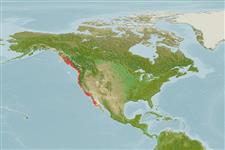Environment: milieu / climate zone / depth range / distribution range
Ekologi
laut dasar (demersal); kisaran kedalaman 0 - 200 m (Ref. 2850). Subtropical; 58°N - 26°N, 137°W - 112°W
Eastern Pacific: Sitka, southeastern Alaska to Punta Abrejos, central Baja California, Mexico.
Size / Weight / umur
Maturity: Lm ? range ? - ? cm
Max length : 99.0 cm TL jantan/; (Ref. 2850); Berat maksimum terpublikasi: 14.0 kg (Ref. 27436); Umur maksimum dilaporkan: 13 Tahun (Ref. 56049)
deskripsi pendek
Kunci identifiaksi (pengenalan) | Morfologi | Morfometrik
Duri punggung (Keseluruhan (total)) : 8 - 12; duri punggung lunak (Keseluruhan (total)) : 15 - 18; Duri dubur: 0; Sirip dubur lunak: 11 - 13; vertebrata, bertulang belakang: 35. Caudal fin barely rounded.
Inhabits rocky, sandy and muddy bottoms as well as kelp beds (Ref. 4925). Adults and juveniles feed on crustaceans, fishes and mollusks (Ref. 6885). Commonly captured by sport fishers (from shore, boats or piers) and by scuba divers (Ref. 2850). Flesh is good eating but eggs are poisonous and will make humans violently ill (Ref. 13513).
Eschmeyer, W.N., E.S. Herald and H. Hammann, 1983. A field guide to Pacific coast fishes of North America. Boston (MA, USA): Houghton Mifflin Company. xii+336 p. (Ref. 2850)
Status IUCN Red List (Ref. 130435: Version 2024-1)
penggunaan manusia
Perikanan: komersial; Ikan buruan: ya; Akuarium: Akuarium publik
Alat, peralatan
laporan khas
muat turun XML
Sumber internet
Estimates based on models
Preferred temperature (Ref.
123201): 7.5 - 11.6, mean 8.9 °C (based on 40 cells).
Phylogenetic diversity index (Ref.
82804): PD
50 = 1.0000 [Uniqueness, from 0.5 = low to 2.0 = high].
Bayesian length-weight: a=0.00389 (0.00180 - 0.00842), b=3.12 (2.94 - 3.30), in cm total length, based on all LWR estimates for this body shape (Ref.
93245).
Trophic level (Ref.
69278): 3.6 ±0.47 se; based on food items.
Generation time: 3.2 ( na - na) years. Estimated as median ln(3)/K based on 1
growth studies.
Daya lenting (Ref.
120179): sedang, Waktu penggandaan populasi minimum 1.4 - 4.4 tahun (tm=3; tmax=13; K=0.3, Fec=40,000-90,000).
Prior r = 0.33, 95% CL = 0.22 - 0.50, Based on 4 full stock assessments.
Fishing Vulnerability (Ref.
59153): Moderate vulnerability (37 of 100).
Climate Vulnerability (Ref.
125649): Moderate vulnerability (44 of 100).
Nutrients (Ref.
124155): Calcium = 75.8 [30.9, 167.0] mg/100g; Iron = 0.974 [0.431, 2.041] mg/100g; Protein = 18.4 [16.2, 20.5] %; Omega3 = 0.314 [0.140, 0.892] g/100g; Selenium = 48.9 [24.8, 117.3] μg/100g; VitaminA = 6.13 [2.10, 17.38] μg/100g; Zinc = 0.592 [0.387, 0.936] mg/100g (wet weight);
